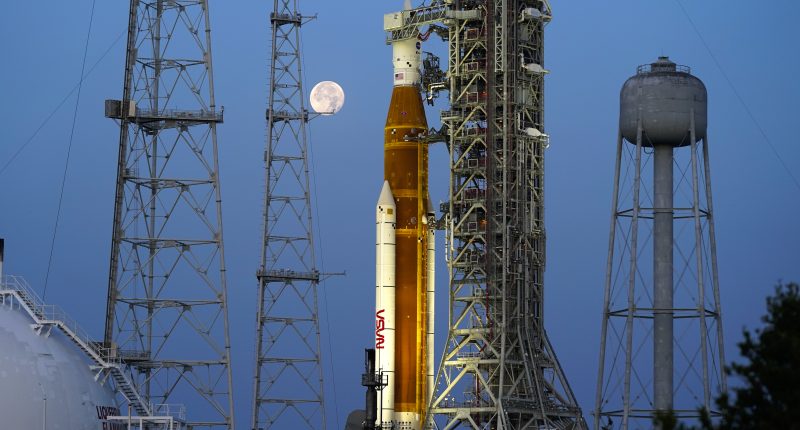NASA has delayed its crewed Artemis Moon missions until 2025 and beyond as the agency requires more time to make its rocket technology safe.
Concerns over Nasa’s Space Launch System rocket means the first crewed Moon landing in over 50 years will take place next year instead, according to the new schedule.
Nasa’s new Artemis timeline:
- Artemis II (the first mission) moved from 2024 to September 2025.
- Artemis III moved from September 2025 to September 2026.
The Artemis IV mission that will take humans to the lunar Gateway space station in 2028 is still on track, the US space agency said.
Nasa’s Space Launch System rocket had already faced a decade of setbacks before it first rolled onto the launch pad in May 2022.
READ MORE ON NASA
The agency said it is pushing the missions back to make sure the crew are safe, as a battery issue still needs to be fixed, alongside circuitry work related to environmental systems, such as air ventilation.
Nasa found the batteries inside the Orion capsule – the module that will house astronauts on their journey – needed replacing after an issue was discovered during vibration testing, Reuters reported.
“We are letting the hardware talk to us so that crew safety drives our decision-making,” said Catherine Koerner, Nasa’s associate administrator of its Exploration Systems Development Mission Directorate.
“We will use the Artemis II flight test, and each flight that follows, to reduce risk for future Moon missions.”
Most read in Tech
An investigation into why the capsule lost char layers during 2022’s uncrewed Artemis I reentry into Earth’s atmosphere is also expected to be completed this spring.
Earlier this week, a Nasa-backed commercial rocket mission to the Moon received the death knell just hours after launching.
The company behind the US’ first Moon mission in 50 years says it may lose control of the spacecraft in less than two days.
Pittsburgh-based Astrobotic admitted that a major fuel leak was pushing the Peregrine One out of alignment.
This means the solar panels that keep it alive are no longer facing the sun, in a critical blow for the mission.
The 1.2 tonne Peregrine lander, which is carrying several Nasa experiements alongside human remains, was initially expected to arrive on the Moon on February 23.
Now, a touch-down on the lunar surface is no longer possible.
“Much like last year, the space industry is off to a shaky start,” said Paul Kostek, a senior member of the Institute of Electrical and Electronics Engineers.
READ MORE SUN STORIES
“This announcement is a temporary setback; it should not have a long-term impact for the spaceport.
“With many competing launches planned later this year and in 2025, the new moon ‘race’ presents an opportunity for countries to position themselves space-industry leaders.”
Find out more about science
Want to know more about the weird and wonderful world of science? From the Moon to the human body, we have you covered…








